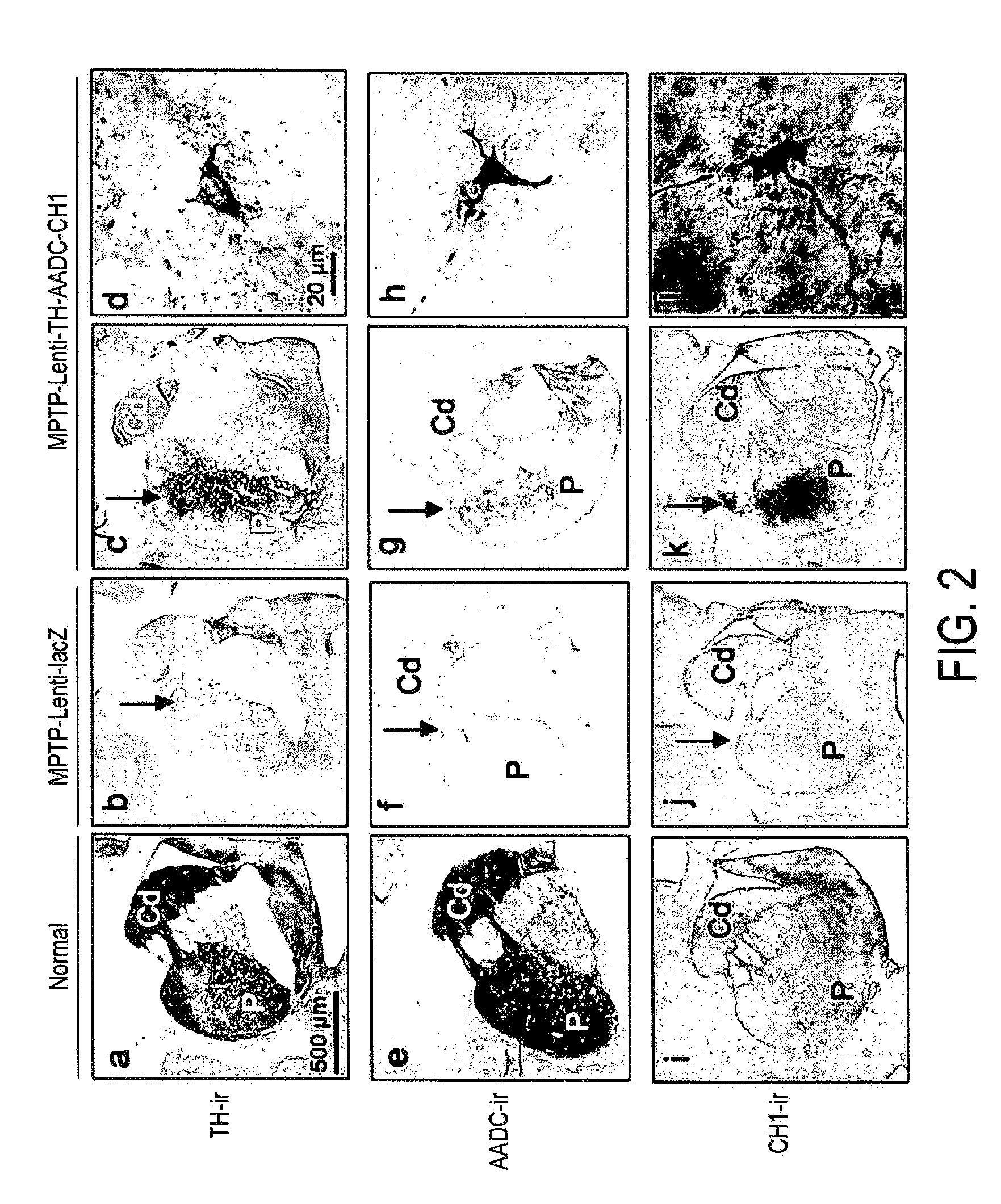Treatment regimen for parkinson's disease
a parkinson's disease and treatment regimen technology, applied in the direction of drug compositions, viruses/bacteriophages, genetic material ingredients, etc., can solve the problems of affecting the quality of life of the affected person, other impairments that are frequently developed, and significant disability, so as to reduce the dosage or maintain the effect of l-dopa and reduce the potential side effects of l-dopa
- Summary
- Abstract
- Description
- Claims
- Application Information
AI Technical Summary
Benefits of technology
Problems solved by technology
Method used
Image
Examples
example 1
Methods
Lentiviral Vector Technology
[0148]A tricistronic lentiviral vector was designed that encodes the genes for TH, AADC and CH1 (Lenti-TH-AADC-CH1). To improve vector-mediated dopamine production, a number of changes were made to the original EIAV vector genome that expressed the tricistronic cassette called pONY8.1TSIN (Azzouz et al (2002) J. Neurosci. 22:10301-10312). These changes led to at least a 2 log increase in dopamine production per integrated genome as assessed in vitro after transduction of human HEK293T cells (FIG. 6).
Local Dopamine Depletion in Animal Models
[0149]To model advanced PD in non-human primates, the selective neurotoxin MPTP was systemically administered to adult Macaca fascicularis until they reached a severe and stable bilateral Parkinsonian syndrome, including akinesia, flexed posture, balance impairment and tremor. Before MPTP treatment, all primates scored 0 on the clinical rating scale (CRS). After MPTP, but before any lentiviral injection, macaques...
example 2
Long Term Motor Behavioural Restoration
[0176]To investigate the potential of gene transfer of TH, AADC and CH1 to correct Parkinsonism, a long term study was performed in the MPTP primate model of PD. A tricistronic lentiviral vector was designed that encodes the genes for TH, AADC and CH1 (Lenti-TH-AADC-CH1). One to eight weeks after the cessation of MPTP intoxication, 18 MPTP treated macaques were assigned into three behaviourally equivalent groups. The first group (MPTP-Lenti-TH-AADC-CH1, n=6) received bilateral injections of Lenti-TH-AADC-CH1 into each motor putamen. The second group (MPTP-Lenti-lacZ, n=6) received a control EIAV vector encoding the LacZ reporter gene. The third group (MPTP-long term, n=6) did not receive any surgical intervention but were included as an additional control to evaluate the stability of the MPTP model. All animals were maintained throughout the study without treatment using L-Dopa or dopaminergic drugs.
[0177]Animals treated with Lenti-TH-AADC-CH1 ...
example 3
Local and Continuous Dopamine Production in Motor Striatum
[0178]To investigate in vivo gene transfer and lentiviral mediated dopamine production, histological analysis of transgene expression was performed and local dopamine levels were measured in the striatum of study animals. Animals treated with Lenti-LacZ were demonstrated to have an average of 54 947 transduced cells per injected putamen, which were mostly neurons (NeuN-ir positive >90%, FIG. 10). Histological analysis also demonstrated that TH, AADC and CH1 positive neurons were evident in the vicinity of the putaminal injection site in MPTP Lenti-TH-AADC-CH1 treated animals but not in MPTP-Lenti-lacZ controls (FIG. 2).
[0179]To quantitatively measure lentiviral mediated dopamine production in the putamen, two indices were applied: (1) whole tissue dopamine levels [DA]wt, measured by post-mortem analysis of striatal punches: this index quantifies both intracellular dopamine (presynaptic nigral dopaminergic terminals) and extra...
PUM
| Property | Measurement | Unit |
|---|---|---|
| Time | aaaaa | aaaaa |
Abstract
Description
Claims
Application Information
 Login to View More
Login to View More - R&D
- Intellectual Property
- Life Sciences
- Materials
- Tech Scout
- Unparalleled Data Quality
- Higher Quality Content
- 60% Fewer Hallucinations
Browse by: Latest US Patents, China's latest patents, Technical Efficacy Thesaurus, Application Domain, Technology Topic, Popular Technical Reports.
© 2025 PatSnap. All rights reserved.Legal|Privacy policy|Modern Slavery Act Transparency Statement|Sitemap|About US| Contact US: help@patsnap.com



